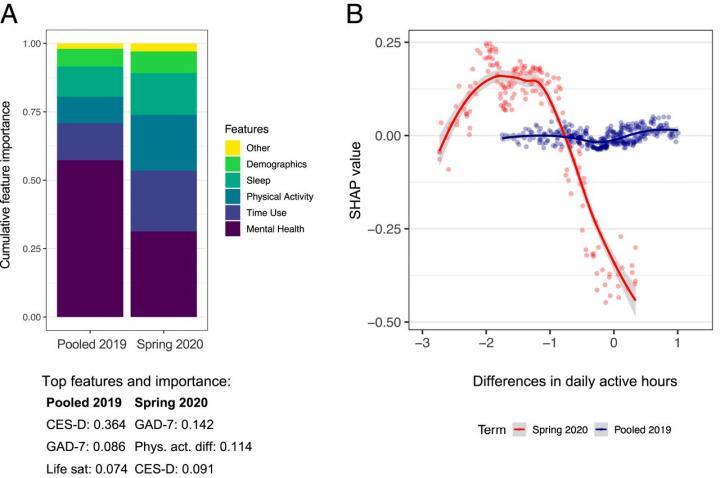
IMAGE: In a study of college students conducted before and during the pandemic, findings revealed the average steps of subjects declined from 10,000 to 4,600 steps per day and rates of…
view more
Credit: Pheelings Media
Exercise has long-been recommended as a cognitive-behavioral therapy for patients of depression, yet new evidence from the University of California of San Diego suggests that the COVID-19 pandemic changed the nature of the relationship between physical activity and mental health.
In a study of college students conducted before and during the pandemic, findings revealed the average steps of subjects declined from 10,000 to 4,600 steps per day and rates of depression increased from 32% to 61%.
The research, recently published in the Proceedings of the National Academy of Sciences, also revealed short-term restoration of exercise does not meaningfully improve mental well-being.
“This raises many possible explanations, including that the impact of physical activity may require a longer-term intervention,” said co-author Sally Sadoff, associate professor of economics and strategy at UC San Diego’s Rady School of Management. “At the same time, our results clearly show that those who maintained physical exercise throughout the pandemic were the most resilient and least likely to suffer from depression.”
Sadoff added there is a 15 to 18 percentage point difference in depression rates between participants who experienced large disruptions to their mobility, compared those who maintained their habits.
Sadoff and coauthors from the University of Pittsburg and Carnegie Mellon University point to the alarming trend of increased depression among young adults (ages 18-24) during the pandemic, which is two-times higher than the general population.
The students in the study answered repeated surveys about their well-being and time use over the course of a semester. From March to July 2020, depression rates skyrocketed by 90%, compared to pre-pandemic levels.
Fitbit data helps fill in the gaps in understanding mobility’s role in mental health
The study enrolled multiple cohorts of hundreds of U.S. college students from February 2019 through July 2020. In addition to filling out surveys, participants received wearable devices (Fitbits) that track their activity levels. Participants in the 2020 cohort began the study in February and continued participating after their university moved all classes online in March and encouraged students not to return to campus.
Among the subjects, sleep increased by 25 to 30 minutes per night, time spent socializing declined by more than half (less than 30 minutes per day), and screen time more than doubled to five or more hours per day.
The researchers found large declines in physical activity during COVID-19 was most strongly associated with higher rates of depression. Physical activity minutes translate to about 10 minutes in which the heart rate is raised enough to burn at least 1.5 times as many calories as it does at rest.
Those who experienced declines of one to two hours of physical activity per day were most at risk for depression during the pandemic. While participants who were able to maintain their daily habits were at the lowest risk for depression.
“This relationship is one that only emerges during the pandemic,” the authors note. “Before the pandemic, there was not a very strong connection between changes in physical activity and mental health, but our analyses suggest that disruption to physical activity is a leading risk factor for depression during this period.”
Short-term restoration of exercise habits does not provide mental health relief
In order to examine whether a policy intervention could help counteract some of the pandemic’s adverse impacts to mental health, the researchers implemented a randomized experiment.
Half of the participants were incentivized to walk at least 10,000 steps per day for two weeks. The strategy significantly increased their average steps by about 2,300 steps per day and physical activity by almost 40 min per day, compared to the other half of subjects. However, the impact of exercise did not translate into an improvement in mental health, nor did it encourage the students to keep up the physical activity after the two-week period ended.
“Physical activity may have important interactions with other lifestyle behaviors such as social interactions,” the authors write. “It could also be the case that the relationship between physical activity and depression is driven more by mental health than it is by lifestyle habits.”
They conclude more research is needed to understand how to improve both physical and mental health during such periods of large disruption.
Adding, “The pandemic tightened the relationship between the maintenance of lifestyle habits and mental health.”
###
Co-authors include Osea Giuntella, assistant professor of economics at the University of Pittsburg; Kelly Hyde, graduate student in the department of economics at the University of Pittsburg; and Silvia Saccardo, assistant professor of management at Carnegie Mellon University.
Disclaimer: AAAS and EurekAlert! are not responsible for the accuracy of news releases posted to EurekAlert! by contributing institutions or for the use of any information through the EurekAlert system.
